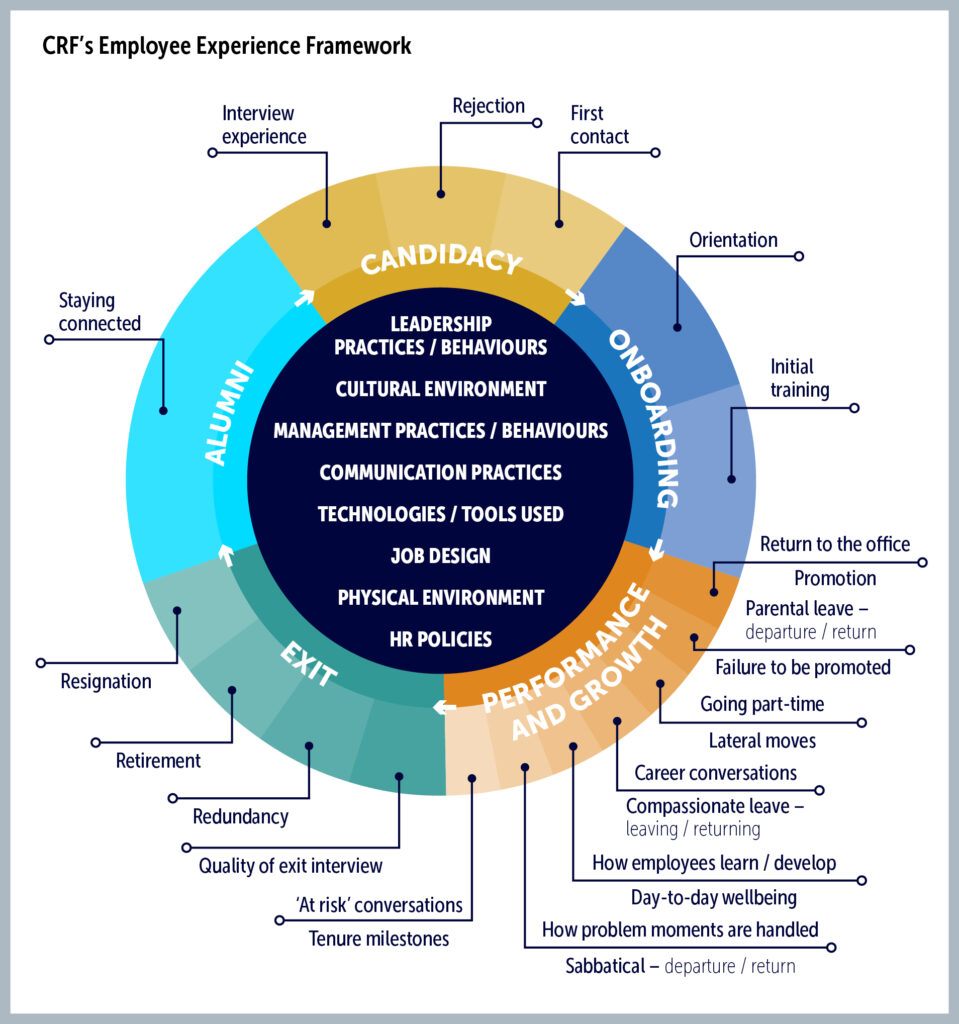Employee Experience and High-Performance Culture
Summary Notes: Embedding D&I in the Employee Experience Lifecycle
On December 7th, CRF hosted an online discussion for the Diversity, Inclusivity and Wellbeing (DI&W) community on the topic of embedding D&I into the employee experience lifecycle. Chaired by CRF Commercial Director, Melissa Bull, and Will Pemberton, CRF’s Digital Content and Events Manager, topics discussed included practitioner experiences and challenges in embedding D&I into the employee experience, as well as ways to attract, retain and develop diverse talent. This summary shares key insights from the discussion.
Beyond Engagement: Creating a Purposeful Employee Experience
Will Pemberton shared an overview of CRF’s 2021 research Beyond Engagement: Creating a Purposeful Employee Experience, which found that:
- Most companies focused on the employee experience for full-time, in-house staff (rather than part-time or contract workers).
- Organisations did not tend to focus on creating differentiated experiences for their employees. For example, only 14% differentiated their employee experience offerings by job level.
- ‘Moments that matter’ or ‘critical moments’ have a major and long lasting impact on the employee experience. Transition periods, such as departing for and returning from parental leave, are one key example of this. An employee’s experience of this period in their life will likely be influenced by their relationship with their line manager, role modelling from senior leaders, the organisational culture, and even the quality of the technological tools that support the process.
- As part of this research, CRF created an Employee Experience Framework, outlined below:

ONS Data: Labour Market Trends
Will provided an overview of recent Office for National Statistics (ONS) data regarding three demographic groups who have increasingly withdrawn from the labour market – the over 50s, the long-term sick and female workers – and ways that they could potentially be supported to re-enter work. Refer here for further details of the ONS data.
50+ Workers
- There are now 0.25m fewer people aged 50-64 in the labour market than before the pandemic. These are not people who were going to retire anyway – the vast majority reported that they finished work sooner than expected. Key reasons for leaving included stress, mental health, illness or disability, and, increasingly, a ‘change in lifestyle’.
- Factors that could potentially encourage this cohort back to work include flexible working hours, being able to work from home and the ability to fit their work around their caring responsibilities.
Long-term sick
- Long-term sickness is at record levels – 2.6m people are self-declared to be out of work and not looking due to ill health (most commonly mental health, musculoskeletal conditions and respiratory illnesses including long covid).
- Some of this population could be encouraged to return to work, if given the right support.
Women who are economically inactive
- Whilst more and more women have entered the workforce over the last 20 years, this trend stopped at the start of the pandemic and did not return once the pandemic eased and the economy normalised. This has been primarily driven by women looking after the family or home.
Practitioner Insights
Participants also shared their experiences and challenges in embedding D&I into a purposeful employee experience, as well as ways that they more broadly attract, retain and develop diverse talent.
Talent Attraction and Hiring Processes
- Members highlighted that when jobs are only advertised internally (or when the same external sources are used repeatedly), this can lead to an over-reliance on the same, homogenous talent pool. They are therefore looking at ways to open up the pools of talent they draw on to attract a more diverse workforce.
- Similarly, another member shared that all roles must be advertised internally for two weeks (rather than a manager being able to choose who they promote). If they do not receive a sufficiently diverse range of applicants, they then open up the role to external applicants.
- Some sectors experience particular challenges in attracting and retaining diverse talent. For example, members working in the manufacturing or engineering industries noted that their sectors were male-dominated and that they struggled to attract women, particularly to technical roles.
- One organisation shared a range of work they had undertaken to increase diversity in their new hires and talent pipeline. This included working closely with local authorities and job centres (particularly working to hire care givers and the long-term unemployed), conducting careers fairs at various stages of education, and supporting parents returning to work. They are now working on building their brand visibility of this D&I work they have implemented.
Culture and Benefits
- One organisation shared they are refreshing their parents and carers policies to make them more relevant for the modern working world. This includes providing more flexibility and also recognising that proving more leave can reduce sickness or time off overall.
- Another member highlighted that, due to the results of an employee engagement survey, they updated the benefits they offered (including policies relating to fertility, the menopause, parental leave and long-term sick pay).
- Global companies can face challenges as they must navigate different cultural contexts and national laws regarding the diversity agenda.
Attracting Workers Back to the Workplace
- Members discussed their experiences of bringing older, retired employees back to the workplace. Two organisations shared that older workers may be brought back as contract workers or due to the personal relationships they have with senior leaders. Whilst this helps to maintain institutional knowledge and knowledge transfer, they shared that it can also prevent them from expanding their talent pool. Additionally, they shared that women are more likely to have administrative than technical experience, preventing them from returning to work as contract workers.
Women in Leadership
Several participants shared their struggles in ensuring representation of women in senior leadership roles. They highlighted the following interventions:
- Launching a programme to support women in acquiring the confidence, skills or ability that they need for senior roles.
- The importance of buy-in from top leadership was also highlighted. For example, one member shared that encouraging senior male sponsorship of women during promotion cycles led to a substantial increase in the number of women promoted to senior leadership.
Learning and Development
- One organisation implemented an ‘all staff DE&I learning journey’ following the Black Lives Matter movement, which focused on a range of topics including anti-racism, disability, social class and LGBTQIA+ issues. This included sessions specifically designed for executive team members and collaborating with an external DE&I expert to lead sessions and facilitate discussions. They also ensured that they were approaching their commercial activities from a DE&I lens and employees also had to undergo compliance training every 18 to 24 months.
- Another participant shared they have implemented unconscious bias training to address an exclusionary culture amongst senior leaders.
Further Resources
CRF. 2021. Beyond Engagement – Creating a Purposeful Employee Experience https://www.crforum.co.uk/research-and-resources/research-report-beyond-engagement-creating-a-purposeful-employee-experience/
CRF. 2023. Summar Notes: HRD Community – Labour Market Trends https://www.crforum.co.uk/research-and-resources/summary-notes-hrd-community-labour-market-trends/
The next DI&W community event will take place on 14th March 2024, with the topic to be shared in due course.
MEMBER LOGIN TO ACCESS ALL CRF CONTENT




